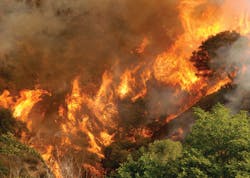Wildland Fires: Early Fire Season For Southern California
On Thursday, Jan 16, 2014, at around 5:50 A.M., three young men had an illegal campfire going at the start of Colby Trail in the Angeles National Forest in California to ward off the cold. This is where the Colby Fire got its name.
Gusty Santa Ana winds that had been blowing for the previous few days were again forecasted to blow on that day, got going and the predictable occurred. The winds picked up embers from the campfire and spread them to the brush. The three men took off running and even though they had cell phones, none of them called 911. They were apprehended later that morning.
The brush, historically dry from no rain and months of hot weather and Santa Ana winds, exploded and started a run to the southwest and toward many homes. The winds were blowing from 15 to 25 mph with higher gusts in the foothills of Glendora and Azusa. The Glendora Police Department switchboard lit up like a Christmas tree, said Lieutenant Lamborghini, adding, “It wasn’t a matter of who called, but of who didn’t call.”
The Los Angeles County Fire Department had a full brush response going within two minutes. The first engine on scene reported had an acre or two of brush going, but the crew had no access to the fire. By this time, the department had its helicopters in the air and the Super Scooper pilots were told to be ready to launch at day break, which was only 10 minutes away. The aircraft from Canada had been scheduled to leave earlier, but officials extended the stay another month due to the Red Flag conditions. Angeles National Forest started scrambling to get units and camp crews started toward the ever-growing column of smoke.
The fire was generating a huge column of smoke that was pushing to the southwest, indicating a strong Santa Ana wind. Responding firefighters from all over the area knew it was going to be a long day.
As I was enroute to the fire, I could see an ever-enlarging smoke cloud. On the scanner I heard the incident commander first call for five strike teams of Type 1 engines, then 30 seconds later, he made it an additional 15 strike teams, or 100 engines, needed immediately. Companies from the California Department of Forestry and Fire Protection (CAL FIRE), Los Angeles City, Beverly Hills and Verdugo, among others, along with numerous strike teams from Los Angeles County started toward the fire. Some of these companies had been pre-deployed due to the extreme conditions.
Arriving resources were sent to direct fire attack or structure protection. Palm trees were exploding downwind from the main firefront due to flying embers and the first column of black smoke indicating a structure taking off made itself visible from halfway up a hill. Although five homes were lost and numerous structures damaged during the fire, this was a tremendous “save” for all units operating at this fire as the area had hundreds of huge one- and two-story homes. The quick response of the Super Scoopers and additional air tankers, along with numerous water-dropping helicopters, were vital in keeping the losses to a minimum. The Super Scoopers had a water source one minute away in the Santa Fe Dam Recreation area and were able to make a three- to four-minute turnaround, as were the helicopters that made many drops around and onto homes to cool down the fire.
By 10 A.M., firefighters caught a break from Mother Nature as the strong winds died down and the smoke column went straight up, indicating a wind change. Firefighters and the aircraft became more aggressive in the fire attack as the tide was turning in the favor of the firefighters.
Looking back, it most probably may have been a good thing that the fire started only three to four miles from a natural firebreak, the 210 Freeway. Had it started miles farther up, it would have had a huge start with nothing in front of it but tens of thousands of acres to burn. As it was firefighters and aircraft were all over this fire from the get-go and even though, sadly, five homes were lost, the loss could have been astronomical. The fire did advance all the way to Highway 39, or San Gabriel Mountain Road, where firefighters were able to pick up hotspots. The fire was contained about 10 days after it started.
In all, close to 1,500 firefighters manning more than 140 engines fought the blaze that burned through 2,000 acres of brush that had seen only six inches of rain in 20 months. The Super Scoopers, the S-2s from CAL FIRE and the P2Vs from the U.S. Forest Service were invaluable with their precise drops, as the firefighters and camp crews who hiked up hillsides dragging hoselines and carrying tools made a difference by cutting firebreaks, digging out snags and putting out spot fires next to houses as they contained this very unusual winter brushfire. Three people were injured, including two firefighters who sustained minor injuries What was a very dangerous and costly fire could have been a disaster.
MIKE MEADOWS is a California-based photojournalist who specializes in coverage of wildland firefighting.
Mike Meadows
MIKE MEADOWS is a California-based photojournalist who specializes in coverage of wildland firefighting.






